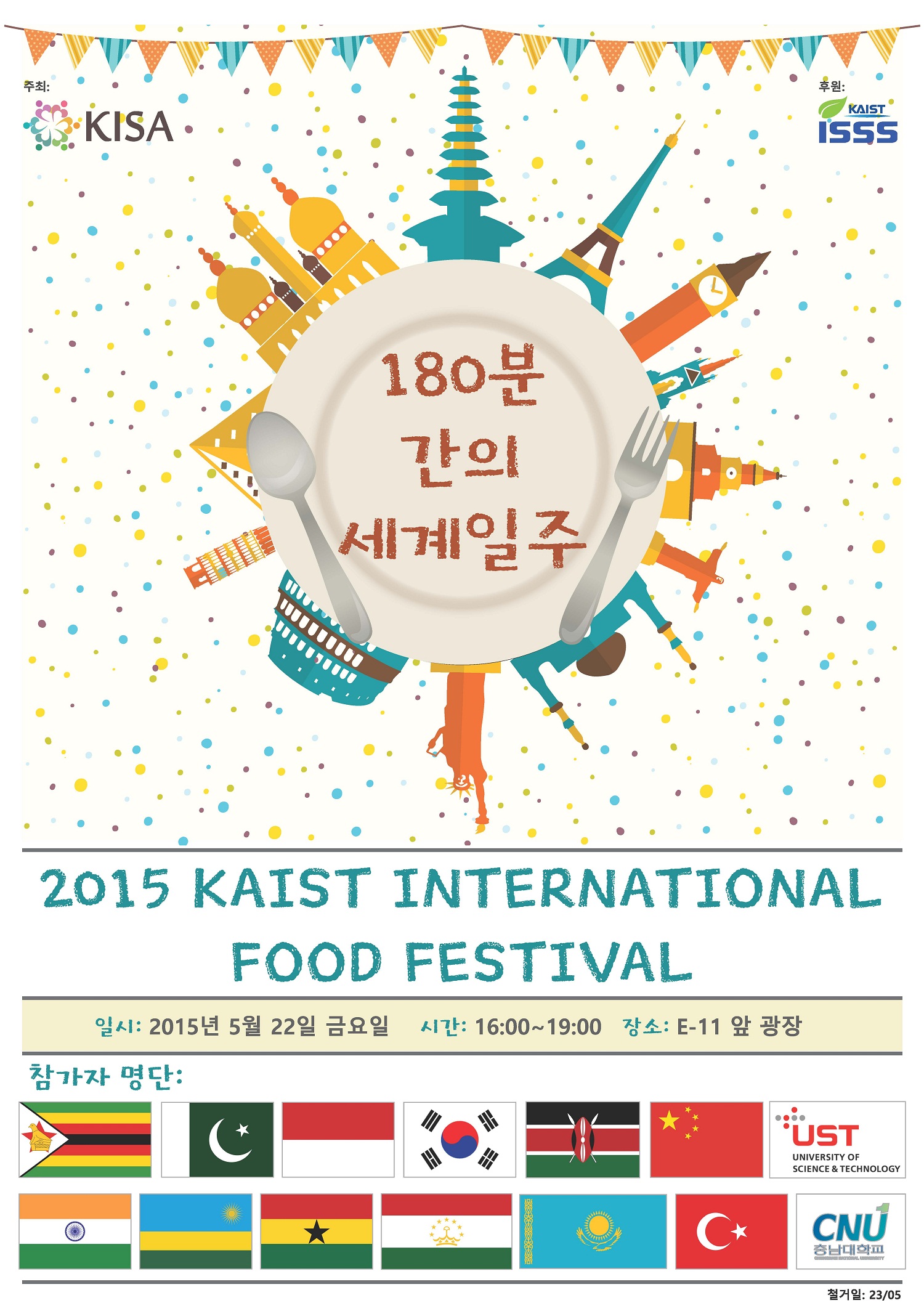event
The KAIST International Students Association (KISA) hosted the 2015 International Food Festival in front of Creative Learning Building, KAIST, on May 22, 2015.
This was the 11th International Food Festival for KAIST where international students introduced food from their home countries to strengthen cultural exchanges with Korean students. This year’s festival was the biggest international festival in Daejeon in which around 500 students and staff from KAIST, Chungnam National University (CNU), the University of Science & Technology (UST), and the public participated.
KAIST’s President Steve Kang opened the festival with a welcoming speech, followed by congratulatory speeches by CNU President Sang-Chul Jung and UST President Un-Woo Lee.
The first section of the event was the food festival where around 40 kinds of food from ten countries including Kenya, Kazakhstan, India, and Turkey were presented. Students from each country offered cooking demonstrations in booths, and participants purchased the food.
Cheryl Wanderi, a Kenyan student who recently received a Master’s degree from KAIST’s Department of Bio and Brain Engineering last February said, “I am delighted to introduce Mandazi, a Kenyan donut, to not only Korean students but also other international students.”
The second half of the event consisted of cultural performances from different countries. There were eight teams performing including an Indonesian traditional Saman dance team, a Kazakh group that performed on traditional instruments, and an Azerbaijani K-POP dance team.
Sung-Hyon Myaeng, the Associate Vice President of KAIST’s International Office, said, “Despite their busy lives, students from three different universities planned this event to get to know each other. I hope international students and Korean students can come together and enjoy the festival.”
Edrick Kwek, the President of KISA, said, “This food festival is an event showing the cultural diversity of KAIST in the most splendid way.”

-
research “One Experiment Is All It Takes”: KAIST Team Revolutionizes Drug Interaction Testing, Replacing 60,000 Studies
A groundbreaking new method developed by researchers at KAIST and Chungnam National University could drastically streamline drug interaction testing — replacing dozens of traditional experiments with just one. The research, led by Professor Jae Kyoung Kim of KAIST Department of Mathematical Sciences & IBS Biomedical Mathematics Group and Professor Sang Kyum Kim of Chungnam National University's College of Pharmacy, introduces a novel analysis technique called 50-BOA, published in Natu
2025-06-16 -
research Breastfeeding Helps Prevent Mothers from Developing Diabetes after Childbirth
A team of South Korean researchers found that lactation can lower the incidence and reduce the risk of maternal postpartum diabetes. The researchers identified that lactation increases the mass and function of pancreatic beta cells through serotonin production. The team suggested that sustained improvements in pancreatic beta cells, which can last for years even after the cessation of lactation, improve mothers’ metabolic health in addition to providing health benefits for infants. Pre
2020-04-29 -
research Blood-Based Multiplexed Diagnostic Sensor Helps to Accurately Detect Alzheimer’s Disease
A research team at KAIST reported clinically accurate multiplexed electrical biosensor for detecting Alzheimer’s disease by measuring its core biomarkers using densely aligned carbon nanotubes. Alzheimer’s disease is the most prevalent neurodegenerative disorder, affecting one in ten aged over 65 years. Early diagnosis can reduce the risk of suffering the disease by one-third, according to recent reports. However, its early diagnosis remains challenging due to the low accuracy but
2020-02-07 -
research A New Spin Current Generating Material Developed
(Professor Park(left) and Ph.D. candidate Kim) Magnetic random-access memory (MRAM) is a non-volatile device made of thin magnetic film that can maintain information without an external power supply, in contrast to conventional silicon-based semiconductor memory. It also has the potential for high-density integration and high-speed operation. The operation of MRAM involves the control of the magnetization direction by exerting spin current-induced torque on a magnetic material. Spin current
2017-12-08 -
event The 2017 International Food Festival
The savory smell of exotic dishes filled the main plaza of the KAIST campus on May 26. Exotic music reverberated throughout the campus. The KAIST community took a break together on a breezy early summer Friday afternoon sharing food with their friends and family. KAIST international student body, KISA (KAIST International Students Association), installed white food tents and prepared their country’s favorite dishes at their 13th annual International Food Festival. The festival
2017-05-29